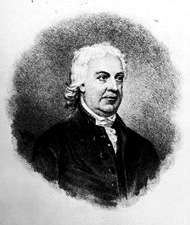Samuel Livermore
Samuel Livermore (May 14, 1732 – May 18, 1803) was a U.S. politician. He was a U.S. Senator from New Hampshire from 1793 to 1801 and served as President pro tempore of the United States Senate in 1796 and again in 1799.
Samuel Livermore | |
|---|---|
 | |
| President pro tempore of the United States Senate | |
| In office December 2, 1799 – December 29, 1799 | |
| Preceded by | James Ross |
| Succeeded by | Uriah Tracy |
| In office May 6, 1796 – December 4, 1796 | |
| Preceded by | Henry Tazewell |
| Succeeded by | William Bingham |
| United States Senator from New Hampshire | |
| In office March 4, 1793 – June 12, 1801 | |
| Preceded by | Paine Wingate |
| Succeeded by | Simeon Olcott |
| Member of the U.S. House of Representatives from New Hampshire's 3rd at-large congressional district | |
| In office March 4, 1789 – March 3, 1793 | |
| Preceded by | Office established |
| Succeeded by | John Samuel Sherburne |
| Personal details | |
| Born | May 14, 1732 Waltham, Province of Massachusetts Bay, British America |
| Died | May 18, 1803 (aged 71) Holderness, New Hampshire, U.S. |
| Political party | Pro-Administration Federalist |
| Alma mater | College of New Jersey |
| Profession | Law |
Life and career
Livermore was born in Waltham in the Province of Massachusetts Bay, the son of Hannah (Brown) and Samuel Livermore,[1] and attended Waltham schools. He graduated from the College of New Jersey (now Princeton University) in 1752, then studied law, was admitted to the bar in 1756, and commenced practice in Waltham. He moved to Portsmouth, in 1758 and later to Londonderry. He was a member of the New Hampshire General Court (the state's general assembly) 1768–1769. He was judge-advocate in the Admiralty court and Attorney General from 1769 to 1774. He moved to Holderness in 1775 and was State attorney for three years.
Livermore was a Member of the Continental Congress from 1780 to 1782 and again from 1785 to 1786. He was Chief Justice of the New Hampshire Superior Court of Judicature from 1782 to 1789, and a member of the State constitutional convention in 1788. He was elected to the United States House of Representatives for the First and Second Congresses, serving from March 4, 1789, to March 4, 1793. He was chairman of the House Committee on Elections in the Second Congress.
Livermore was president of the State constitutional convention in 1791 and in 1792 was elected as a Federalist to the United States Senate and was reelected in 1798 and served from March 4, 1793, until his resignation effective June 12, 1801, due to ill health. He served as President pro tempore of the Senate during the Fourth and Sixth Congresses. The defunct town of Livermore, New Hampshire was named after him.
Livermore died in Holderness, New Hampshire, and is interred in Trinity Churchyard there. He is featured on a New Hampshire historical marker (number 39) along New Hampshire Route 175 in Holderness.[2]
Livermore was the father of Arthur Livermore, a U.S. Representative from New Hampshire, and Edward St. Loe Livermore, a U.S. Representative from Massachusetts.
References
- "List of Markers by Marker Number" (PDF). nh.gov. New Hampshire Division of Historical Resources. November 2, 2018. Retrieved July 5, 2019.
External links
- United States Congress. "Samuel Livermore (id: L000364)". Biographical Directory of the United States Congress.
- Samuel Livermore at Find a Grave
| U.S. House of Representatives | ||
|---|---|---|
| Preceded by Seat established |
Member of the House of Representatives from New Hampshire's At-large (Seat 3) congressional district 1789–1793 |
Succeeded by John Samuel Sherburne |
| U.S. Senate | ||
| Preceded by Paine Wingate |
U.S. senator (Class 2) from New Hampshire 1793–1801 Served alongside: John Langdon, James Sheafe |
Succeeded by Simeon Olcott |
| Political offices | ||
| Preceded by Henry Tazewell |
President pro tempore of the United States Senate May 6, 1796 – December 4, 1796 |
Succeeded by William Bingham |
| Preceded by James Ross |
President pro tempore of the United States Senate December 2, 1799 – December 29, 1799 |
Succeeded by Uriah Tracy |

